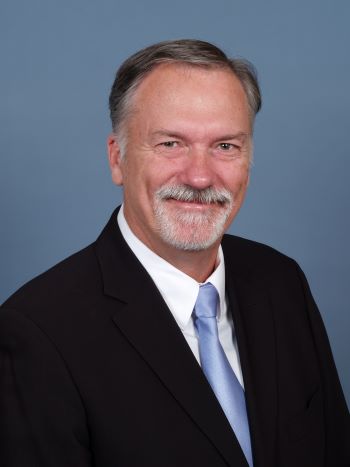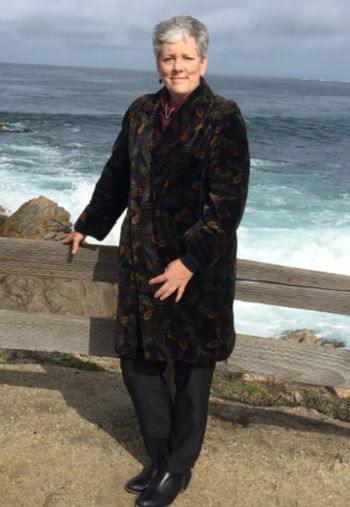CALCode Quarterly Summer 2024

 Stoyan Bumbalov
Stoyan Bumbalov
Greetings, CALCode Quarterly readers. I hope you have had an enjoyable summer. I know that I am looking forward to the cooler days ahead.
The California Building Standards Commission (CBSC) staff has been diligently working to administer the rulemaking process for 43 code amendment proposals submitted by state agencies for the 2024 Triennial Code Adoption Cycle. During a triennial cycle, the state is required by law to adopt the most recent edition of applicable model codes published by the International Code Council, the International Association of Plumbing and Mechanical Officials and the National Fire Protection Association.
State amendments to the model codes include regulations required by new laws or executive orders, or continuing efforts by state agencies to meet goals and objectives laid out for them in prior years, in addition to eliminating any duplication of, or conflicts with, California law. Additionally, all past approved California amendments must be carried forward to maintain consistency in the regulations. This is a colossal task that requires coordination and cooperation between CBSC and many other state agencies.
During this cycle, the biggest proposed change is to place all building standards related to wildland urban interface into Part 7 of Title 24, which is currently vacant. This proposal will result in a single code book with regulations from the California Building Code, the California Residential Code, the California Fire Code, Titles 14 and 19 of the California Code of Regulations, and sections from the Government, Health and Safety, and Public Resources Codes.
As you can tell, the rulemaking process administered by CBSC is voluminous and complicated. To learn more, please read our Cycle Status and Commission Action Matrix articles below, and then take the quiz to test your knowledge.
Throughout 2024, we are celebrating the 15-year anniversary of the California Green Building Standards Code, Part 11 of Title 24, also known as CALGreen. In this edition of CALCode Quarterly, we feature an interview with former CBSC Executive Director Dave Walls (2006 – 2011) who was integral in the development of this first-in-the-nation green building code back in 2008. We are also pleased to share news about a new CALGreen informational website that is the result of coordination between CBSC, the Division of the State Architect, the American Institute of Architects – California, the Statewide Codes and Standards Enhancement Team, and other stakeholders. More information can be found in the sidebar of this newsletter.
I am happy to share that we have two Staff Spotlights in this edition. First, we are celebrating the promotion of Pamela Maeda to the position of Associate Governmental Program Analyst. Pamela has been with CBSC since 2014. She is a valued member of our administrative staff who helps senior staff stay on track and cares for our commissioners. New to CBSC’s staff is Associate Architect Woo Cheong. Woo is a licensed architect who has specialized in health facility design throughout his career. Learn more about Pamela and Woo in the featured articles below.
Next up for CBSC is preparation for the next three commission meetings. The October meeting will include commission business such as approval of past meeting minutes and an overview of current legislation affecting CBSC, and will not have any code adoption agenda items. The December 2024 and January 2025 meetings will mostly be to review, approve and adopt the model codes and California amendments. Make sure you’re signed up for our mailing list to receive the meeting announcements.
Until then, CBSC will be hard at work documenting public comments received and organizing the rulemaking packages for commission review. Stay safe and enjoy your autumn!
Feature Articles
The 2024 Triennial Code Adoption Cycle will result in the publication of the 2025 edition of the California Building Standards Code, Title 24 of the California Code of Regulations (Title 24), that will be published on July 1, 2025, and go into effect on January 1, 2026.
A code adoption cycle entails many steps, which are divided into four main categories on CBSC’s Rulemaking webpage: pre-cycle, code advisory committee (CAC) reviews, public comment periods, and commission review and approval at public meetings. The different phases allow for the development and review of code proposals, and for the affected public to provide input. Throughout the cycle, everything is a proposal and nothing is final until it is approved by the commission. This cycle, the commission meetings will be in December 2024 and January 2025.
During a triennial cycle, CBSC administers the process of adopting and amending several national model building codes that form the foundation of Title 24. This is a gargantuan feat, requiring coordination of over a dozen state agencies that have the authority to propose and adopt building standards. Although a triennial cycle is touted as lasting 18 months, in actual practice the proposal, review and adoption of new building standards must take place in the first 12 months of the cycle. This is because it takes approximately five to six months to administer the codification and publication of new regulations (more about this in the next CALCode Quarterly).
So, within a 12-month period, proposing state agencies must submit their proposals to CBSC, participate in CAC reviews, respond to CAC recommendations, prepare their documents for 45-day public comment periods (and potentially a second public comment period of 15 or 45 days), respond to all public comments, and then prepare a final package for commission review. All of these actions must be documented in the rulemaking paperwork.
CBSC—in accordance with the California Administrative Code, Part 1 of Title 24—orchestrates six CAC meetings: 1 – Accessibility (ACCESS), 2 – Building/Fire/Other (BFO), 3 – Green Building (GREEN), 4 – Health Facilities (HF),
5 – Plumbing/Electrical/Mechanical/Energy (PEME) and 6 – Structural Design/Lateral Forces (SDLF). These categories are then used to organize the packages for 45-day public comment periods, which are phased so that they follow CAC reviews. Due to the time limits of a rulemaking cycle mentioned above, the public comment periods overlap.
Currently in the 2024 cycle, the public comment periods are wrapping up. The ACCESS comment period closed on September 9. The GREEN and PEME public comment period ended on July 1, with the additional 15-day comment period ending on August 13. Finally the HF, BFO and SDLF comment period will conclude on October 21.
As soon as an agency’s rulemaking proposal has emerged from its public comment period, agency staff begin the process of preparing the required documents for review and approval by the commission. This includes responding to every public comment, whether or not a change was made to the proposed building standard. The whole process is required to be transparent to the public, so the rulemaking documents are posted on CBSC’s website for viewing or downloading. The steps in the cycle are also tracked in a document called the Commission Action Matrix (CAM). So, if a person is interested in seeing at a glance what has happened with a proposal, they can refer to the CAM (see the “Code Adoption Matrix” article in this edition of CALCode Quarterly).
For more details about rulemaking, check out these additional resources:
“About the Title 24 Rulemaking Process” (video)
“Public Guide to the Rulemaking Process” (guidebook)
CALCode Quarterly Newsletter archive (webpage)
How to Use the Commission Action Matrix to Follow Code Proposals
The Commission Action Matrix (CAM) is a California Building Standards Commission (CBSC) document that summarizes the progression of building standards proposals through the rulemaking process, from the initial submittal for Code Advisory Committee (CAC) review through commission review and approval for adoption (or disapproval). It is presented as a table that is filled in during the phases of the code adoption cycle. There is a separate CAM for the state agencies’ proposals for each part of Title 24, and they are posted on CBSC’s website along with other rulemaking documents such as the Express Terms and Statements of Reasons.
The first iteration of the CAM has a lot of blank space. It is divided into items and sub-items based on the proposed code amendments in the Express Terms, and has a brief description of the proposal in the “Annotations” column. Each line item has a space to indicate the CAC recommendation, the agency’s response to the recommendation, public comments, and finally, the action taken by the commission on the final proposal.

Examples in this article are from the CAM for the 2022 Intervening Cycle proposals for the California Green Building Standards Code, Part 11 of Title 24 (CALGreen).
Code Advisory Committee Meeting
The CBSC staff member who is responsible for the proposal will attend and monitor the public CAC meeting, and then fill in the “CAC Action” column for each item. CAC actions are: Approve, Approve as Amended, Return for Further Study, or Disapprove. These recommendations are not binding to the proposing agency. The agency responds when they resubmit their proposals for a public comment period. At that time, the “Agency Response” column is filled in with either “Accept” or “Disagree.” This version of the CAM is then posted for the public to view during a 45-day public comment period.
45-Day Public Comment Period
Interested parties can see the CAC recommendation and the nine-point criteria from Health and Safety Code Section 18930 cited to support the recommendation. Also in the “Annotations” column, viewers can see the state agency’s response to a recommendation for amendment or further study of a proposal. Since the CAM is just a summary, details about any changes made can be found in the Statement of Reasons that is also posted for public viewing.


Commission Meeting
For a commission meeting, three different CAMs may be posted. A green CAM contains uncontested items, a yellow CAM is for challenged items, and a salmon CAM shows items that have been withdrawn by the state agency and therefore require no commission action. The CAM colors were introduced in the past when physical binders were printed for the commissioners to review. Now, commissioners receive their binder materials electronically and the CAMs are posted on CBSC’s website as Word documents, therefore, they are not actually published on colored paper. The colors are indicated in the file name and in the page footer of each CAM.
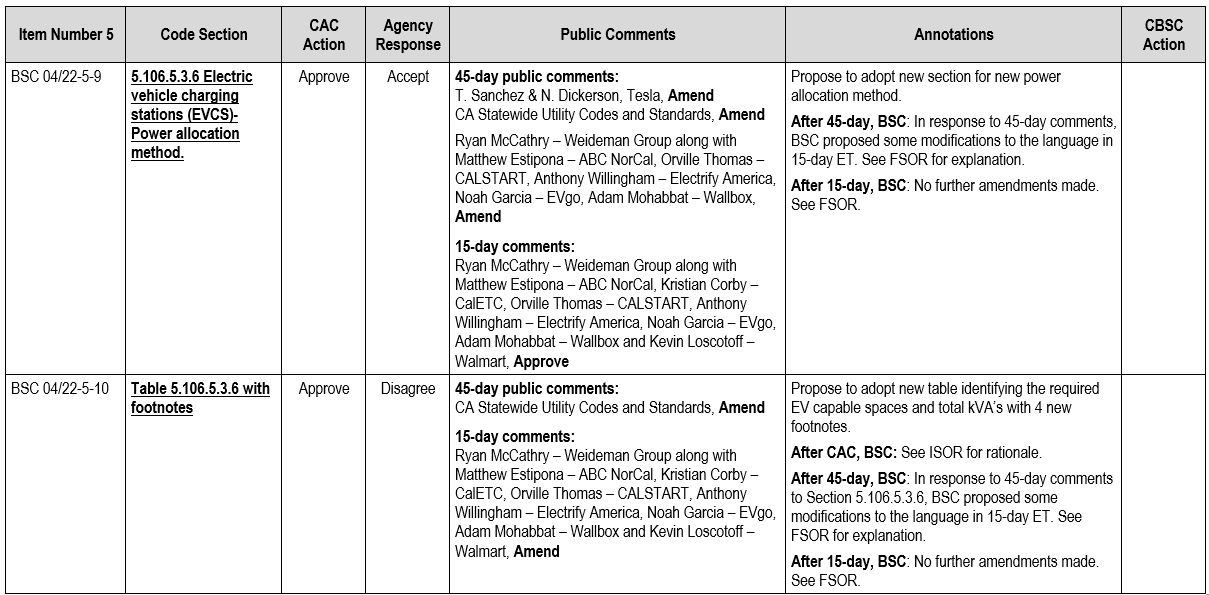

Approved Standards
After the commission meeting, the CAMs are finalized to show the commission’s action on each item. They are posted along with the approved Express Terms that have been filed with the Secretary of State and that will be published for inclusion in Title 24.
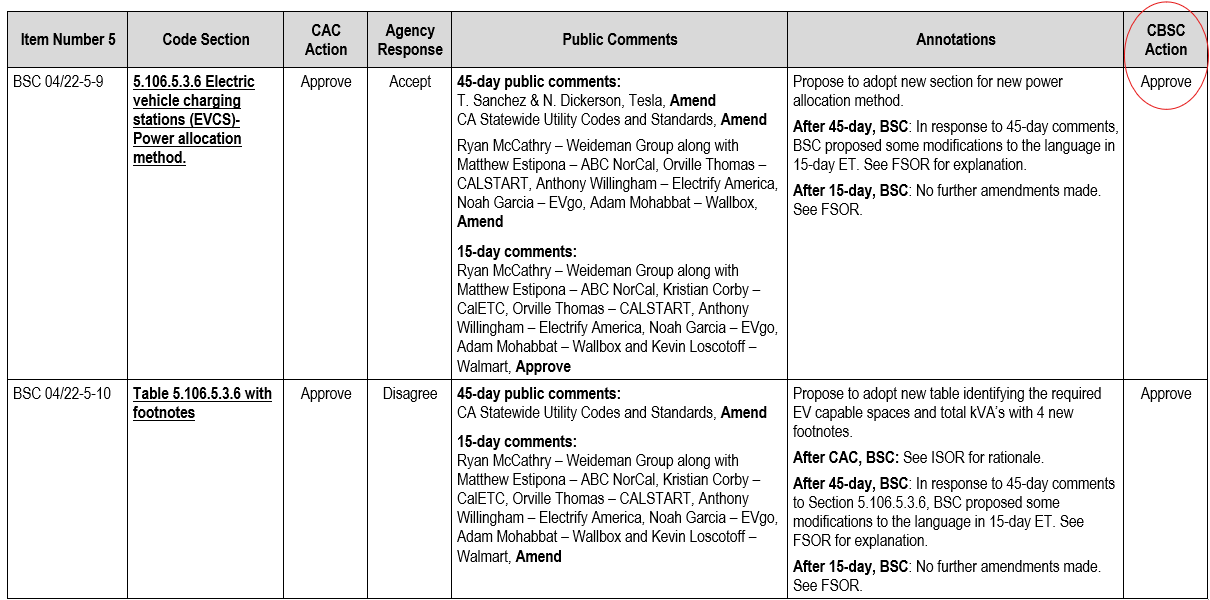
In conclusion, for someone who wants an at-a-glance summary of the progress of a code proposal through the phases of an adoption cycle, the CAM provides a quick and simple reference.
Next, take this quick quiz to test your knowledge about CAMs.

Former CBSC Executive Director David Walls Recalls Birth of CALGreen
Celebrate with us all year as we recognize the 15th anniversary of the publication of CALGreen, the first-in-the-nation green building standards code! CALCode Quarterly reached out to former California Building Standards Commission (CBSC) Executive Director David (Dave) Walls (2006 – 2011) to learn more about the conception and development of the California Green Building Standards Code, Part 11 of Title 24, known as CALGreen.
What were your initial thoughts when you heard about the directive to develop sustainable building codes?
"When the [administration] asked me what I could do to “green the codes” in February 2007, my initial thoughts were that it should be an easy lift because it seemed—at the time—that everyone was moving in that direction. Obviously, I was a bit naïve."
What did you find most useful or inspirational when deciding how to structure and write the regulations?
"The governor gave us a blank slate on how to accomplish his request, so we organized a workshop to explore the various possibilities. Ultimately, we decided that a green code was the best way to provide consistency statewide, as opposed to developing a guide or a rating system, which were some of the recommendations. Our goal was to structure the code utilizing the green building measures that were most common to the construction industry [already], rather than try to “reinvent the wheel.” The measures that ended up in CALGreen were inspired by existing green rating systems, guidelines, and other published documents that were in the marketplace at the time."
What were some of the challenges or roadblocks? How did you overcome them?
"I believe the biggest challenge was overcoming the stakeholders’ perceptions of what the final code would become. The various stakeholders had different ideas of whether the provisions of the code would go too far, wouldn’t go far enough, or interfere with the existing green rating systems. We [faced some resistance, and] it almost seemed overwhelming at times, but we continued to work with stakeholders to shape the code into…usable, cost-effective provisions that provided significant environmental standards for buildings in California."
How did you feel at the end of the process, when the first edition of CALGreen was published?
"When we published the first edition in 2009, we were all very excited. It was an incredible team effort for all who participated in the successful development and adoption of CALGreen. The first edition’s provisions were voluntary and provided an important framework for the 2010 edition. It…remains the only statewide mandatory green code in the U.S."
Were there any exciting/fun/happy moments? Please share!
"I think finalizing the adoption of the 2010 version of CALGreen was probably the most exciting and joyful moment. It was a culmination of a team effort involving state agencies and the public that brought the vision of a green code to life.
Another gratifying moment occurred during the California Senate oversight hearing when I was asked to present about the process of CALGreen’s development and adoption. During the public testimony portion of the meeting, industry groups, environmental organizations, and labor groups all had favorable comments in support of CALGreen and the open and transparent process used by CBSC to gain consensus among stakeholders."
Anything else you’d like readers to know?
"I would like to add that Doug Hensel, with the Department of Housing and Community Development at the time, was critical in the successful development of CALGreen. We worked together closely to overcome the challenges, draft the code language, and structure the code. We also teamed up to provide educational and training opportunities to inform the industry and public about the benefits of CALGreen."
Be sure to check out the next edition of CALCode Quarterly for more about CALGreen’s history and development.
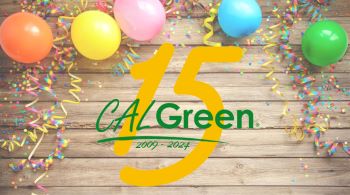
Pamela (Pam) Maeda was recently promoted to Associate Governmental Program Analyst in recognition of her continued outstanding service to CBSC. To learn more about Pamela, check out her biography on our About Us webpage. And now, please join us in singing Pam’s praises (to the tune of “Maria” from Sound of Music).
How do you praise a colleague like Pam-e-la?
How do you sum her up and make it grand?
How do you find some words that mean Pam-e-la?
Let us try…we’ll do our best…all for our PAM!
Many a task she does to make life easier.
So many things she knows and understands.
When you ask her what she likes about her job
She’ll say “Eve-ry-thing…”
And then list them all! It’s something that astounds!
She writes PPMs for us all to use!
Researches and reconciles issues that bemuse!
Serving others is her specialty,
Just ask the commissioners, executives, and office team!
She wants more time in the day to do it all,
But do it all she does!
Meeting deadlines every time is her goal!
And working together with an awesome team
Makes her want to be at work each day!
Serving others brings her joy,
And for us she’s such a treasure,
She brings life and light to CBSC,
And her value we can’t measure…
She's a darling! She's an angel! She's our PAM!
Woo Cheong joined CBSC in July and has quickly acclimated to our fast-paced work environment. As an associate architect, Woo will assist with the adoption and amendment of model codes during the current triennial code adoption cycle. In July, CBSC held three code advisory committee meetings, so he was able to begin his learning process by observing one of the first stages of the rulemaking process. CALCode Quarterly checked in with Woo to see how his first months are going.
Since starting with CBSC, have you been surprised by anything you’ve learned about Title 24 and the rulemaking process?
"I am continually surprised by the complexities of the rulemaking process. I’ve come to realize that it involves many layers of review and team efforts. We need to be diligent and proactive, as coordinating with multiple state agencies within strict timelines is crucial. Additionally, all our rulemaking actions must be clear and well-documented. Before joining CBSC, I had a superficial understanding of rulemaking activities. Now, I am amazed by the detailed systematic nature of the process. I’m on an exciting learning curve, discovering new aspects of the work every day."
Please tell us about one of the most memorable experiences in your career so far.
"I was deeply moved when I attended the dedication ceremony for Sacramento Korean Presbyterian Church. It was nearly 20 years ago, and this was my first project after moving to California. The timing of the project was particularly poignant, as our family had just emerged from a challenging period. The church is prominently located on the north side of Highway 50 in El Dorado Hills."
Were there any challenging situations you had to overcome when you practiced architecture in the private sector?
"It was quite challenging when the design team was blamed for a potentially critical design error that could have resulted in significant financial loss. Our team managed to resolve the issue with relatively minor adjustments to the smoke compartment and fire wall layout and details. At that time, I was reminded of the importance of teamwork and the power of brainstorming."
What are you looking forward to here at CBSC as you work on the development of Title 24?
"I will be proud to contribute to the development of Title 24, as it represents our team’s effort to enhance the environment for the health and safety of Californians. I hope to be a valuable member of the team."
Anything else you’d like to share?
"I would be grateful for any advice. I am new to rulemaking, as my previous career was almost exclusively focused on building design, with most of my duties related to drawing and technical aspects. Now, I am tackling quite different tasks related to rulemaking—no more drawing. I’m excited by this new challenge but also frustrated by my limited knowledge in this area. Please bear with me as I work to stand on my own and eventually start running for our team. Hi hee ho ho!"
Thanks for sharing, Woo!
Learn more about Woo by reading his biography on our About Us webpage.

Updated Resource and Future E&O Event

If you’re a representative of a local jurisdiction, please be sure to check out the updated Guide for Local Amendments of Building Standards – CBSC was asked by the Department of Housing and Community Development (HCD) to provide updated information regarding how local jurisdictions are to submit their amendments to Title 24 relative to universal design in housing, earthquake protection, accessory dwelling units, and emergency housing due to homelessness or natural disaster. Importantly, HCD has created an online portal for these filings. Please contact HCD directly with questions. The portal and contact information can be found on HCD’s Local Ordinances webpage.

Energy Transition Summit 2024 – Sacramento – October 8 & 9 –Supervising Architect Irina Brauzman will represent CBSC on a state agency panel at the Energy Transition Summit hosted by the Energy Transition Coordinating Council (ETCC). This in-person gathering will be moderated by staff from the California Energy Commission and will focus on energy efficiency and decarbonization technologies. In addition to the state agency panel, sessions will include information about electric vehicles and building decarbonization.
Education and Outreach

Danish Energy Agency – June 18 – California Building Standards Commission (CBSC) Executive Director Stoyan Bumbalov and Supervising Architect Irina Brauzman attended a meeting with the Danish Energy Agency that was convened by the California Energy Commission (CEC). The representatives from Denmark were interested in learning more about mandatory energy regulations in the California Energy Code, Part 6 of Title 24, and the new mandatory embodied carbon reduction regulations in the California Green Building Standards Code, Part 11 of Title 24 (CALGreen).

Korea Disabled People’s Development Institute – July 3 – Delegates from a South Korean organization for persons with disabilities visited CBSC to learn more about accessibility regulations in Title 24. CBSC staff members were joined by representatives from the Department of Housing and Community Development (HCD), responsible for the development of Chapter 11A of the California Building Code (CBC, Part 2 of Title 24), and the Division of the State Architect (DSA), responsible for the development of Chapter 11B of the CBC. CBSC’s newest employee, Woo Cheong, assisted in facilitating the meeting by providing some translation services and helping to explain the unique rulemaking systems of each country. Deputy Executive Director Kevin Day graciously accepted the delegates’ gift of some traditional tea, which was later enjoyed by staff at CBSC’s office.

Livable Buckhead – July 12 – CBSC met on Zoom with representatives of Livable Buckhead, an organization in Buckhead, Georgia, that focuses on sustainability and quality of life in their community. They were interested in finding out about the challenges and successes experienced by CBSC and DSA during the development of the new embodied carbon reduction regulations in CALGreen. Supervising Architect Irina Brauzman and DSA Principal Architect Eric Driever spoke with Livable Buckhead’s Executive Director Denise Starling and Sustainability Manager Helen Petersen for an hour, answering questions about collaboration with stakeholders and implementation of the regulations.
The State of Washington – July 12 – CBSC and DSA met virtually with representatives from the state of Washington to discuss the development of mandatory embodied carbon reduction regulations in CALGreen. Washington State Department of Commerce Director Hanna Waterstrat, and Josh Brown of the Washington State Building Code Council asked questions of CBSC Executive Director Stoyan Bumbalov and Supervising Architect Irina Brauzman, alongside State Architect Ida Clair and Principal Architect Eric Driever from DSA.

CBSC and DSA are happy to share experiences and insights with other code development organizations looking to expand their building regulations for a more sustainable and accessible built environment in California and around the world.
SB Architects – San Francisco – August 23 – CBSC’s CALGreen subject matter expert, Associate Construction Analyst Enrique Rodriguez, presented information about the most recently adopted mandatory and voluntary CALGreen regulations. In this one-hour session, Enrique covered a brief history of CALGreen, and the newest regulations relative to embodied carbon reduction, electric vehicle charging, and bird-friendly construction. He also shared information about how those who are interested can participate in the process of developing building standards. For more information about public participation in rulemaking, please visit our Resources webpage.

CALGreen Info website – During the recent intervening code adoption cycle, CBSC, DSA, the American Institute of Architects of California, and the Energy Codes & Standards Team—members of the CALGreen Carbon Reduction Collaborative (CCRC) workgroup—committed to sharing information with stakeholders regarding the new mandatory embodied carbon reduction regulations, as well as other building standards in CALGreen. The CALGreenInfo.com website was developed to be a one-stop shop for information regarding CALGreen codes. If you have any suggestions for the page, you can contact the page developers at feedback@CALGreenInfo.com or reach out to us at cbsc@dgs.ca.gov.
Spring 2024 Quiz - Question #6 Clarification
One of the reasons CBSC provides quizzes in its newsletters is to make sure readers understand the information shared. In the last quiz, some people were unclear about one of the alternative methods for complying with electric vehicle (EV) charging requirements. Here is additional information about a question that more than half of the respondents answered incorrectly.
Q: Two Low Power Level 2 receptacles can be substituted for:
a. Two direct current fast chargers
b. One EV Capable Space without EVSE (Correct answer) – See Section 5.106.5.3.2.2 of CALGreen.
c. One Level 2 charger – This incorrect answer was selected by 57% of respondents.
Refer to the above code section, or to pages 13 through 17 of the 2022 CALGreen Supplement Guide available to download from our CALGreen webpage.

